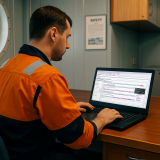A harbor tug developed by Keppel Offshore & Marine and outfitted with technology from ABB is continuing to establish new levels in the efforts to move to automation. The tug’s autonomous operations for collision avoidance were recently verified making it the first vessel in the world to receive Autonomous and Remote-Control Navigation Notation from classification society ABS and the first Singapore-flagged vessel to receive the Smart (Autonomous) Notation from MPA.
According to ABB, the notations acknowledge the breakthrough performance of the tug as it helps to advance the field of autonomous operations. The demonstration of the autonomous collision avoidance capabilities in trials conducted at Raffles Reserved Anchorage, off Singapore Island, in March 2022, came just a year after the same vessel, the Maju 510, became the world’s first vessel to secure the ABS Remote-Control Navigation Notation, following initial remote operation trials at the Port of Singapore in April 2021.
The 105-foot-long harbor owned and operated by Keppel Smit Towage is being used to demonstrate the emerging technologies designed to both improve safety as well as relieve the crew of tasks that can be automated, enabling them to perform at their best during critical periods. Keppel O&M is the project lead for the autonomous solutions on the Maju 510, with the digital technologies developed by ABB.
During the most recent trials, the tug demonstrated its ability to autonomously avoid collisions in various scenarios, such as when two other vessels approach simultaneously on colliding paths and when a nearby vessel behaves erratically. The trials were supervised by an onboard tug master.
“I had the pleasure of being aboard Maju 510 during the collision avoidance trials and experiencing how smoothly the tug performed in autonomous mode,” said Romi Kaushal, Managing Director, Keppel Smit Towage. “What I found particularly impressive was how the digital system identified one or several risks in the tug’s planned path and responded to set the vessel on a new, safer course. The vessel performed as if it was operated by an experienced tug master.”
By allowing the crew to focus on the overall situation rather than on performing specific maneuvers, ABB says that the technology enhances safety and efficiency in tug operations. They point out that it can be particularly important in congested shipping hubs like Singapore. Furthermore, the systems can be upgraded to enable higher levels of autonomy depending on local regulations and the requirements of the vessel.
“As the systems integrator, Keppel O&M collaborated with ABB on customizing the autonomous solutions to enhance the vessel’s operational safety and efficiency. By liberating the crew of time- and energy-consuming tasks and improving accuracy during critical maneuvers, our autonomous solution has proven its ability to increase safety in even the busiest of ports. The autonomous solutions are future-ready to handle the growing demand of tug operations in Singapore port,” said Aziz Merchant, Executive Director, Keppel Offshore & Marine.
ABB points out that while the technology is being demonstrated on tugs, the same technology can be applied to a variety of vessel types including wind turbine installation vessels, cruise ships, and ferries. In another recent demonstration of the autonomous technology, the ice-class passenger ferry Suomenlinna II was remotely piloted through the Helsinki harbor. The companies believe that the successful demonstrations and verification by class societies are helping to move the industry a step closer to autonomous operations.
Source: https://www.maritime-executive.com/article/next-level-of-vessel-autonomy-verified-on-singapore-tug



 S-100 now supports imagery and gridded data, high-density bathymetry, and dynamic under keel clearance management in ECDIS, in addition to many other maritime data applications. Thanks to this, the standard will enrich the next generation of data products for hydrographic, maritime shipping, and geographic information system communities.
S-100 now supports imagery and gridded data, high-density bathymetry, and dynamic under keel clearance management in ECDIS, in addition to many other maritime data applications. Thanks to this, the standard will enrich the next generation of data products for hydrographic, maritime shipping, and geographic information system communities.





